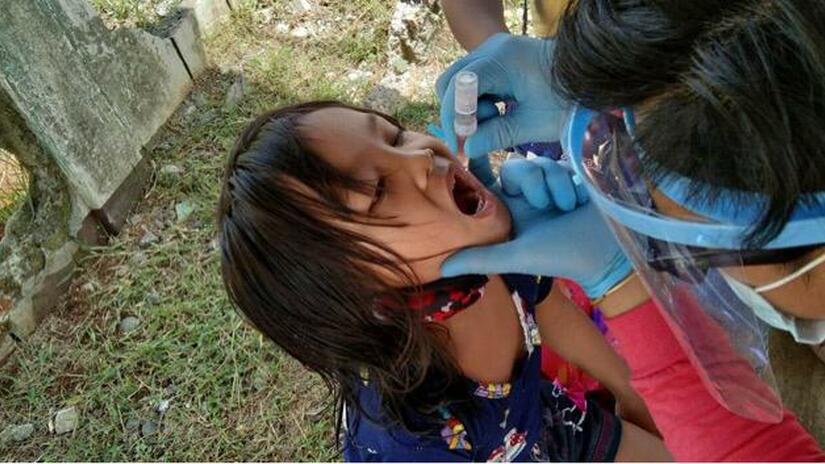We are on the verge of wiping out polio again in the Philippines, a battle many of us have been waging for decades.
Growing up with neighbors and schoolmates who wore leg braces for limbs withered from polio, I didn't realize that polio was an ancient scourge that globally maimed or killed tens of thousands of people every year.
My first job as an assistant to the Philippines Health Secretary 30 years ago gave me the privilege to work on eliminating the wild poliovirus that was living in nine million Filipino children when then Health Secretary Juan Flavier launched an immunization campaign called "Oplan Alis Disis" -- Remove Sickness -- that was based on a simple strategy: mobilize the 3 "M"s: mayors, midwives, and the media.
Calling for a "Ceasefire for Children," the Philippines established local "peace zones" in areas of best by armed conflict. There we were able to deliver polio drops and other lifesaving vaccinations against measles, diphtheria, pertussis, tetanus, and Vitamin A -- regardless of religion, socio-economic status, or political affiliation.
In response, mothers, fathers, and grandparents brought nine million children -- some dressed in their Sunday best -- to receive vital polio drops at health centers adorned with balloons, bands, and freebies as if for a fiesta. It took ten years of consistent routine vaccination, interspersed with national immunization days and the constant education of families in health centers, to the point of eradicating polio. By the time I became Undersecretary of Health in 1998 and by 2000, the Philippines was declared "polio-free."
Yet polio is back. Today, I am seeing Red Cross volunteers and staff wearing face masks and shields standing alongside government health teams as they scour the densely populated slums of Metro Manila, going door to door to administer polio vaccine drops. After almost 20 years being polio-free, the virus has returned. The COVID-19 crisis has only made it more difficult for health workers. Today stands as one of the most dangerous periods in decades, with thousands of children not receiving vital polio vaccinations because of the lockdown.
There are other problems too. Some Red Cross vaccination teams are welcomed with smiles, with families grateful that they do not have to bring their children to a health facility where they are afraid of contracting the COVID-19 virus. But for many other families, the fear of contracting COVID-19 is so great that they refuse to open their doors, speaking only through their windows.
We must not allow COVID-19 to block out the message that the Philippines government has embarked on a new effort to halt the spread of polio.
Take the example of Mary Rose Amauin, who refused to talk to Red Cross volunteers at first when they knocked on her door in August and her husband claimed their child had already been vaccinated. Patiently the Red Cross volunteers urged Mary Rose to reconsider. After all her questions were answered, Mary Rose eventually allowed her 10-months-old baby, Bianca to receive the drops, apologizing that she was more cautious as times are tough because of COVID-19.
For Philippine Red Cross volunteer Merlita Daygo, patience and kindness have helped her convince other hesitant parents like Mary Rose to allow their children to be vaccinated. She knows that taking the time to clearly explain the purpose of the vaccine will help save children's lives. Without a house-to-house vaccination campaign, many children would miss their polio vaccination.
As part of the preparation for the mass polio vaccination, volunteers and staff undergo training on how to handle refusals and how to keep everyone safe. Another volunteer vaccinator Mary Grace Kafilas told me how sad she feels when parents decline the polio vaccine. On the first day of a recent vaccination push in Rizal, seven parents refused the vaccination. What hurts so much is that it's such a simple, easy measure to prevent a life-threatening virus
I am encouraged by parents whose children have contracted polio and who now strongly advise and encourage other parents to take immunization seriously. Polio infections have occurred for thousands of years and was portrayed in ancient Egyptian paintings and carvings. But it was only in the 1940s and 1950s that polio epidemics infected more than half a million people around the world every year, inflicting a lifetime of paralysis, and in some cases death.
As we celebrate the great success of the eradication of the wild poliovirus in Africa, we must remember that national immunization days and the strengthening of routine vaccinations through grassroots mother and child health programs played a critical role in ridding an entire continent of this terrible disease.
As the global race for a COVID-19 vaccine heats up, we must also remember that today millions of children in the Philippines also need lifesaving polio drops to address its re-emergence. In the middle of the worst pandemic in 100 years, let's make sure we take the last steps.
This article first appeared in the Nikkei Asian Review
Article
Gaza: A family of volunteers, helping others while they themselves cope with the hard realities of conflict
Gaza: A family of volunteers, helping others while they themselves cope with the hard realities of conflict
| Article

